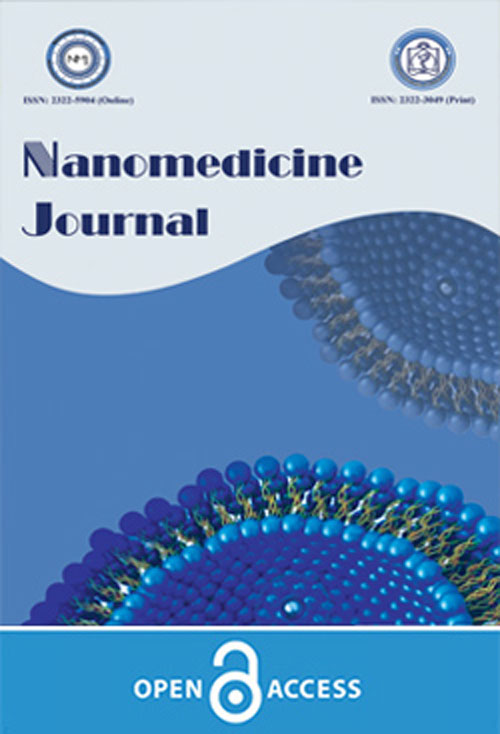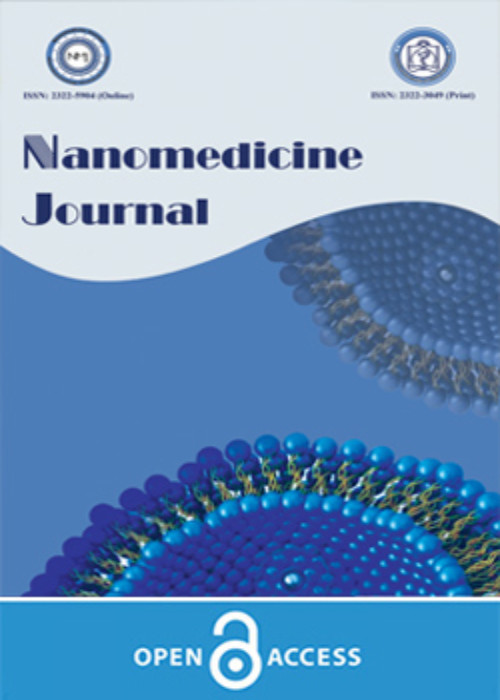فهرست مطالب

Nanomedicine Journal
Volume:3 Issue: 2, Spring 2016
- تاریخ انتشار: 1395/01/25
- تعداد عناوین: 8
-
-
Pages 69-82The existing health care systems focus on treating diseases rather than preventing them. Patients are generally not testedunless physiological symptoms are appeared. When they do get tested, the results often take several days and can be inconclusive if the disease is at an early stage. In order to facilitate the diagnostics process and make tests more readily available for patients, the concept of point of care testing (POCT) has been brought up and developed in recent years. Field effect transistors (FET) using nanomaterial as a kind of biosensors have shown great characteristics for detection of a wide range of biomolecules due to their label-free, real time and ultrasensitive properties. In this paper, first of all, the working principles of such devices and recent developments in fabrication methods and surface functionalization are stated, and then some current research trends in field-effect transistor nanobiosensors are highlighted. Eventually key advantages and challenges of FET-based nanobiosensors as POCT devices are discussed as well.Keywords: Field effect transistor, FET, based nanobiosensor, Nanobiosensor, POCT
-
Pages 83-94Silver Nanoparticles (AgNPs) have gained considerable interests during the last decade due to their excellent antimicrobial activities. Despite their extensive use, the potential toxicity of these nanoparticles and possible mechanisms by which they may induce adverse reactions have not received sufficient attention and no specific biomarker exist to describe and quantify their toxic effects. Nanoparticles, depending on their physicochemical characteristics and compositions, can interact with vital organs such as the brain and induce toxic effects. A specific concern is that any contact with AgNPs independent of the route of administration is thought to result in significant systemic uptake, internal exposure of sensitive organs, especially in the central nervous system (CNS) and different toxic responses. There are considerable evidences that AgNPs can disrupt the Blood-Brain Barrier (BBB) and induce subsequent brain edema formation. Therefore, it is essential to understand the differential effects of AgNPs on brain cell with especial emphasis on the possible mechanisms of action. Recently, biomarkers are increasingly used as surrogate indicators of toxic responses in biological monitoring due to the inaccessibility of target organs. Moreover, as the most nanoscale contaminants occur at low concentrations, physiological biomarkers may be better indicators of potential impact of nanomaterials than traditional toxicity testing. This review aims to investigate the effects of AgNPs on CNS targets of toxicity and clarify the role of existing biomarkers especially the role of dopamine levels as a potential biomarker of Ag-NPs neurotoxicity.Keywords: AgNPs, Biomarker, Dopamine, Neurotoxicity, Silver nanoparticlesCentral nervous system
-
Pages 95-108Objective(s)The development of multifunctional nanoprobes for specific targeting and imaging of tumors presents a great challenge. Herein, we report the synthesis and characterization of folic acid (FA) gold nanoparticles (AuNPs) through diatrozic acid (DTA) linking for in vitro and in vivo targeted imaging of HeLa cells by computed tomography (CT).Materials And MethodsIn this study, G5 dendrimers were used as templates to synthesize AuNPs within the dendrimer interiors. The cytotoxicity and hemocompatibility of the particles were evaluated by morphological observation of cells after hematoxylin and eosin staining, cell viability assay, flow cytometric analysis of cell cycle and apoptosis, and hemolytic assay. The cellular uptake of the particles was confirmed through inductively coupled plasma atomic emission spectroscopy determination of silver and transmission electron microscopy. Finally, in vitro and in vivo targeted CT imaging performances were evaluated using HeLa cells and a xenografted HeLa tumor model, respectively.ResultsWe showed that Au DENPs-FA-DTA did not significantly affect cell morphology, viability, or the cell cycle and apoptosis, thereby indicating their good biocompatibility and stability in the given concentration range. Micro-CT images showed that HeLa cells could be detected by X-ray after incubation with Au DENPs-FA-DTA in vitro and that the xenograft tumor model could be imaged after intravenous and intratumoral administration of the particles. The FA-modified AuNPs enabled targeted CT imaging of HeLa cells overexpressing FA receptors in vitro and the corresponding xenografted tumor model in vivo.ConclusionOur results demonstrated that the designed AuNPs show great potential as probes for targeted CT imaging of human cervical cancer.Keywords: Cervical cancer, computed tomography, Dendrimers, Folic acid, Gold nanoparticles
-
Pages 109-114Objective(s)In this study, the effect of electrospun fiber orientation on proliferation and differentiation of mesenchymal stem cells (MSCs) was evaluated.Materials And MethodsAligned and random nanocomposite nanofibrous scaffolds were electrospun from polylactic acid (PLA), poly (vinyl alcohol) (PVA) and calcium carbonate nanoparticles (nCaP). The surface morphology of prepared nanofibrous scaffolds with and without cell was examined using scanning electron microscopy. Mechanical properties of electrospun nanofibrous scaffolds were determined with a universal testing machine. The in vitro properties of fabricated scaffolds was also investigated by the MTT assay and alkaline phosphatase activity (ALP).ResultsThe average fiber diameter for aligned and random nanofibers were 82 ± 12 nm and 124 ± 25 nm, respectively. The mechanical testing indicated the higher tensile strength and elastic modulus of aligned nanofibers. MTT and ALP results showed that alignment of nanofiber increased the osteogenic differentiation of stem cells.ConclusionAligned nanofibrous nanocomposite scaffolds of PLA/nCaP/PVA could be an excellent substrate for MSCs and represents a potential bone-filling material.Keywords: Electrospinnng, Mesenchymal stem cells, Nanofbrous scaffold
-
Pages 115-126Objective(s)First principles calculations were performed to study four multiple sclerosis drugs namely, Ampyra, Fingolimod, Mitoxantrone and Eliprodil in gas and liquid phases using Density Functional Theory (DFT). Computational chemistry simulations were carried out to compare calculated quantum chemical parameters for Ampyra, Fingolimod, Mitoxantrone and Eliprodil.Materials And MethodsAll calculations were performed using DMol3 code which is based on DFT. The Double Numerical basis set with Polarization functions (DNP) was used.ResultsMitoxantrone has highest HOMO energy, global softness, solvation energy and molecular mass and lowest LUMO energy, energy gap, global hardness and total energy in comparison to Ampyra, Fingolimod and Eliprodil in gas and solvent phases. Calculations were carried out to study the interaction of covalently binding Mitoxantrone to functionalized carbon nanotube. The Mitoxantrone local reactivity was studied through the Fukui indices in order to predict both the reactive centers and the possible sites of nucleophilic and electrophilic attacks. The Mitoxantrone binding energy is calculated to be 6.507 eV in gas phase and -9.943 eV in solvent phase that is a decrease in BE as the drug phase changes from gas to liquid.ConclusionThe simulation results show Mitoxantrone is quite a reactive drug. The quantum chemical parameters of pristine nanotube and f-SWNT-Mitoxantrone showed that reactivity of f-SWNT-Mitoxantrone increased in comparison to pristine nanotube in both phases.Keywords: Density Functional Theory Calculations, Functionalized Carbon Nanotube, Multiple Sclerosis Drugs
-
Pages 127-134Objective(s)The current study reports the production and biocompatibility evaluation of a ternary nanocomposite consisting of HA, PLA, and gelatin for biomedical application.Materials And MethodsHydroxyapatite nanopowder (HA: Ca10(PO4)6(OH)2) was produced by burning the bovine cortical bone within the temperature range of 350-450 oC followed by heating in an oven at 800. Synthesis of the ternary nanocomposite was carried out in two steps: synthesis of gelatin-hydroxyapatite binary nanocomposite and addition of poly lactic acid with different percentages to the resulting composition. The crystal structure was determined by X-ray diffraction (XRD), while major elements and impurities of hydroxyapatite were identified by elemental analysis of X-ray fluorescence (XRF). Functional groups were determined by Fourier transform infrared spectroscopy (FTIR). Morphology and size of the nanocomposites were evaluated using field emission scanning electron microscope (FE-SEM).Biocompatibility of nanocomposites was investigated by MTT assay.ResultsXRD patterns verified the ideal crystal structure of the hydroxyapatite, which indicated an appropriate synthesis process and absence of disturbing phases. Results of FTIR analysis determined the polymers functional groups, specified formation of the polymers on the hydroxyapatite surface, and verified synthesis of nHA/PLA/Gel composite. FESEM images also indicated the homogeneous structure of the composite in the range of 50 nanometers. MTT assay results confirmed the biocompatibility of nanocomposite samples.ConclusionThis study suggested that the ternary nanocomposite of nHA/PLA/Gel can be a good candidate for biomedical application such as drug delivery systems, but for evaluation of its potential in hard tissue replacement, mechanical tests should be performed.Keywords: Biocompatibility, Gelatin, Hydroxyapatite, Nanocomposites, Polylactic Acid
-
Pages 135-142Objective(s)The objective of this study was to investigate the antibacterial activities of magnesium oxide nanoparticles (MgO NP) alone or in combination with other antimicrobials (nisin and heat) against Escherichia coli and Staphylococcus aureus in milk.Materials And MethodsFirst, the combined effect of nisin and MgO nanoparticles was investigated in milk. Then the combined effect of nisin, heat and MgO nanoparticles was assessed in milk. Also the scanning electron microscopy was used to characterize the morphological changes of S. aureus before and after antimicrobial treatments.ResultsThe results showed that MgO NP have strong bactericidal activity against the pathogens. A synergistic effect of MgO in combination with nisin and heat was observed as well. Scanning electron microscopy was revealed that MgO NP treatments in combination with nisin distort and damage the cell membrane, resulting in a leakage of intracellular contents and eventually the death of bacterial cells.ConclusionThese results suggested that MgO NP alone or in combination with nisin could potentially be used as an effective antibacterial agent to enhance food safety.Keywords: Antibacterial activity, Foodborne pathogens, Magnesium oxide, Nanoparticles, Nisin
-
Pages 143-146Objective(s)Hardystonite (HT) has been successfully prepared by a modified sol-gel method. We hypothesized that
nano-sized (HT) would mimic more efficiently the nanocrystal structure and function of natural bone apatite, owing to the higher surface area, compare to conventional micron-size (HT).Materials And MethodsThe hardystonite nanopowder was prepared via a modified sol-gel method.Optimization in calcination temperature and mechanicalball milling resulted in a pure and nano-sized powder which characterized by means of scanning electron microscopy(SEM), X-ray diffraction (XRD), transmission electron microscopy (TEM) and fourier transform infrared Spectroscopy
(FTIR).ResultsPure (HT) powders were successfully obtained via a simple sol-gel method followed by calcination at1150 °C. Mechanical grinding in a ceramic ball mill for 6 hours resulted in (HT) nanoparticles in the range of about 32-55nm.ConclusionOur study suggested that nanohardystonite (NHT) might be a potential candidate by itself as a nanobioceramic filling powder or in combination with other biomaterials as a composite scaffold in bone tissue regeneration.Keywords: Hardystonite (HT), Nanobioceramic powder, X-ray diffraction, TEM, SEM, FTIR


